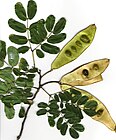Note: This is a project under development. The articles on this wiki are just being initiated and broadly incomplete. You can Help creating new pages.
Albizia lebbeck - Shirisha
Shirisha is a beautiful large deciduous tree found throught India and up to 900m in the Himalayas. The greenish-yellow flowers appear in abundance during the summer filling the air with a rich aroma.
Contents
- 1 Uses
- 2 Parts Used
- 3 Chemical Composition
- 4 Common names
- 5 Properties
- 6 Habit
- 7 Identification
- 8 List of Ayurvedic medicine in which the herb is used
- 9 Where to get the saplings
- 10 Mode of Propagation
- 11 How to plant/cultivate
- 12 Commonly seen growing in areas
- 13 Photo Gallery
- 14 References
- 15 External Links
Uses
Inflammation, Herpes, Skin diseases, Cold and cough, Gastric, Blotches, Pimples, Diarrhea, Sore throats [1]
Parts Used
Chemical Composition
Common names
| Language | Common name |
|---|---|
| Kannada | baage, baage mara, kallu baage |
| Hindi | siris, siras |
| Malayalam | chelinge, kattuvaka, nenmani, nenmeni |
| Tamil | vaagai, vellaivenkai, kattuvakai |
| Telugu | baagichettu, billa, billa vaara, dirisana, dirisanamu, sirasamu |
| Marathi | NA |
| Gujarathi | NA |
| Punjabi | NA |
| Kashmiri | NA |
| Sanskrit | Shirisha, krishnashirisha, mridupushpa, shukapushpa, vishanashana |
| English | Siris |
Properties
Reference: Dravya - Substance, Rasa - Taste, Guna - Qualities, Veerya - Potency, Vipaka - Post-digesion effect, Karma - Pharmacological activity, Prabhava - Therepeutics.
Dravya
Rasa
Kashaya (Astringent), Tikta (Bitter), Madhura (Sweet)
Guna
Tikta (Bitter), Rooksha (Dry), Teeksha(Piercing)
Veerya
Ishat Ushna (Slightly hot)
Vipaka
Katu (Pungent)
Karma
Kapha, Pitta, Vata
Prabhava
Habit
Identification
Leaf
| Kind | Shape | Feature |
|---|---|---|
| Bipinnate | Alternate | pinnae 2-4 pairs, 5.5-12 cm long, slender, glabrous, opposite, even pinnate, leaflets 8-20, opposite, even pinnate, petiolule to 1 mm long, a gland in between each leaflets, 2.7-5 x 1-2.5 cm, obliquely oblong, base of one half cuneate, other round, apex obtuse, margin entire, glabrous above and slightly pubescent beneath, coriaceous; midrib towards distal margin,stipulate; stipules small, free, lateral, cauducous; rachis 7-9 cm long, slender, grooved above, with a gland at its base, glabrous, pulvinate; lateral nerves 6-8 pairs, pinnate, slender, prominent, intercostae reticulate. |
Flower
| Type | Size | Color and composition | Stamen | More information |
|---|---|---|---|---|
| bisexual | 3.5-3.7 cm long | Greenish-white | Many | solitary or 2-4 together in axillary corymbose racemes; peduncle 6-8 cm; bracts linear, cauducous; pedicels to 3 mm. Calyx tube funnel-shaped pubescent, 3-4.5×1.5-3 mm, teeth triangular. Petals united infundibuliform 7-10 mm long, greenish, lobes 5, lanceolate, pubescent without. Stamens many, filament tube shorter than corolla tube, filaments long exserted, green or pink; anthers very small. Ovary subsessile, glabrous, style 2.5 cm, filiform; stigma minute. |
Fruit
| Type | Size | Mass | Appearance | Seeds | More information |
|---|---|---|---|---|---|
| A pod | 20-30 x 4-5 cm | flat, oblong, compressed, straw coloured, base and apex obtuse, turgid above the seeded region | seeds 8-12, 6-10 x 5-8 mm, ovate, dull dark brown, flattened. | {{{6}}} |
Other features
List of Ayurvedic medicine in which the herb is used
Where to get the saplings
Mode of Propagation
How to plant/cultivate
Can be easily grown from seed.
Season to grow
Soil type
Propagation
Commonly seen growing in areas
Photo Gallery
References
- ↑ "Uses"
- ↑ "Vernacular names"
- ↑ [FLOWERING PLANTS OF KERALA VER 2.0, N.SASIDHARAN "BOTANIC DESCRIPTION"]
External Links
- Ayurvedic Herbs known to be helpful to treat Inflammation
- Ayurvedic Herbs known to be helpful to treat Herpes
- Ayurvedic Herbs known to be helpful to treat Skin diseases
- Ayurvedic Herbs known to be helpful to treat Cold and cough
- Ayurvedic Herbs known to be helpful to treat Gastric
- Ayurvedic Herbs known to be helpful to treat Blotches
- Ayurvedic Herbs known to be helpful to treat Pimples
- Ayurvedic Herbs known to be helpful to treat Diarrhea
- Ayurvedic Herbs known to be helpful to treat Sore throats
- Herbs with Leaves used in medicine
- Herbs with Roots used in medicine
- Herbs with Seeds used in medicine
- Herbs with common name in Kannada
- Herbs with common name in Hindi
- Herbs with common name in Malayalam
- Herbs with common name in Tamil
- Herbs with common name in Telugu
- Herbs with common name in Sanskrit
- Herbs with common name in English
- Habit - Tree
- Index of Plants which can be propagated by Seeds
- Herbs that are commonly seen in the region of Tropical area
- Herbs that are commonly seen in the region of Road sides
- Herbs
- Tree




